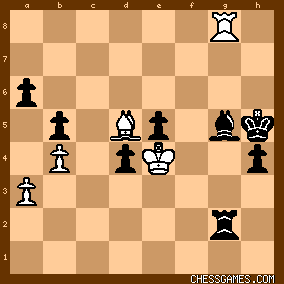| May-04-05 | | BlazingArrow56: Kasparov plays this endgame to perfection! |
|
| May-04-05 | | Poulsen: Sure, but when did the endgame begin?
Whites loss of a pawn in move 15 proves decisive - from that point on black has the initiative AND a material advantage. No wonder that K. won - and no surprise, that it took additional 45 moves or so. |
|
| May-04-05 | | lopium: 13.Rxe3 !! I don't really understand the sacrifice. Maybe only positional, but I guess Kasparov wouldn't have played this move against Deep Junior! |
|
| May-04-05 | | maoam: <lopium>
Kasparov prepared the brilliant 13...Rxe3 for his match with Karpov in 1990. Black get's a huge amount of compensation on the dark squares. What's more, I'm not sure it'd be a bad choice against Deep Junior, after all it came up with 17...0-0! used in Kasimdzhanov vs Kasparov, 2005. |
|
| May-04-05 | | BlazingArrow56: I just read 15. Ncb5 was a prepared novelty by Gelfand. There may be an improvement in there but once Kasparov gets two pawns for the exchange its over. |
|
Dec-29-07
 | | kingscrusher: Brilliant exchange sac. I have video annotated this game at:- http://www.youtube.com/watch?v=29Lj... |
|
| Sep-06-08 | | notyetagm: http://www.chesscafe.com/yaz/yaz.htm
<13 ... Rxe3!?
Yes, indeed! Kasparov, like no other, believes in his ideas. For a full explanation about this sacrifice read my book, Five Crowns.> <26 ... Bg1+!
Correctly playing for the win. Black will have two pawns for the exchange, but more importantly his pieces play a more active role. For example, contemplate the f1-bishop’s role. The overriding considerations for Kasparov in declining the repetition are the open files. White’s rooks will have to penetrate on c7, c8, e7, and/or e8. Since the bishop on h2 will cover c7 and the d7-bishop covers e8 and c8, the remaining “business square” is e7. Black’s king can always slide to f8, so that covers all the bases. <If White is without active rooks and saddled with a passive bishop, Black’s losing chances are nil.>> <28 ... Rd8!
<An important principle in such positions is to avoid exchanging the major pieces when an exchange down.> The extra major piece acts as an important defender. Also, the difference in strength between rooks and minors are emphasized when the minors have to face the rook alone.> |
|
| Sep-07-08 | | notyetagm: 60 ... ♖f2xg2 0-1

click for larger viewhttp://www.chesscafe.com/yaz/yaz.htm:
<Adjourned, but White resigned without resuming. After 61.Kxe5 Bf6+ 62.Kxf6 Rxg8 63.Bxg8 d3 is a case of the overworked bishop. Another very impressive game by Kasparov.> 
click for larger viewAnd now the light-squared White g8-bishop will soon be <OVERWORKED> as it will not be possible for the White bishop to prevent both the Black d3- and h4-passers from promoting by controlling only *one* diagonal. |
|
| Sep-07-08 | | notyetagm: <lopium: 13.Rxe3 !! I don't really understand the sacrifice. Maybe only positional, but I guess Kasparov wouldn't have played this move against Deep Junior!> http://www.chesscafe.com/text/yaz85...:
<Yes, indeed! Kasparov, like no other, believes in his ideas. For a full explanation about this sacrifice read my book, Five Crowns.> Seirawan is saying that he explains this <EXCHANGE SACRIFICE> 13 ... ♖e8x♗e3! in detail in his "Five Crowns" book, as Kasparov first played this idea in his 1990 World Championship match against Karpov. |
|
| Jan-03-10 | | notyetagm: 28 ... ?

click for larger viewWhite has just played 28 ♖d1-e1, offering to trade rooks. Should Black acquiesce to the trade? 28 ... ♖e8-d8! (Seirawan)

click for larger viewNot just no, HELL NO!
http://www.chesscafe.com/text/yaz85...
Seirawan: <<An important principle in such positions is to avoid exchanging the major pieces when an exchange down.> The extra major piece acts as an important defender. Also, the difference in strength between rooks and minors are emphasized when the minors have to face the rook alone.> That is,
♖♖ > ♖♗
but
♖ >> ♗
I made this *exact* strategic mistake in a club game recently, trading off rooks when down the exchange in an endgame. I thought my centralized knight would be strong enough to fight the rook but it was <NO MATCH>. Rooks are just *overwhelmingly* strong in the endgame, much much much stronger than a minor piece. |
|
| Jan-03-10 | | notyetagm: See Wheeler vs notyetagm December Demolition Sven Brask Chess Club 2009 for all the gory details. |
|
| Jan-04-10 | | kingsindian2006: this is a hidden gem of kaspy... beauty of a game |
|
| Mar-31-12 | | PinnedPiece: GTM: Score 85 Par 98
Me skunked although I did go Bg1 before Kasparov, to remove the h2 pawn. Didn't have a lot of time to get through this lengthy game. Very enjoyable, however. |
|
| Apr-15-12 | | Hankanintetrolla: The black bishop in KID is a killer. |
|
Apr-15-12
 | | moronovich: <Hankanintetrolla>
Quite a handle youve got there ;) |
|
May-05-16
 | | Honza Cervenka: 21.Nc2 was bad. 21.a3 allows black to force draw immediately with 21...Na2 22.Rb3 (the Rook must stay on the third rank to cover point e3) 22...Nc1 23.Rc3 Na2 etc., and he is not forced to do that but I don't see any clear way to significant advantage there at least. Also 21.a4 can be worth of consideration. |
|
May-05-16
 | | Honza Cervenka: 47.Be4 could have been better than 47.Ke2. If black plays 47...Ne3+, then 48.Ke2 Nxg2 49.Rxd4 seems to be more defensible ending for white than that in the game. |
|





